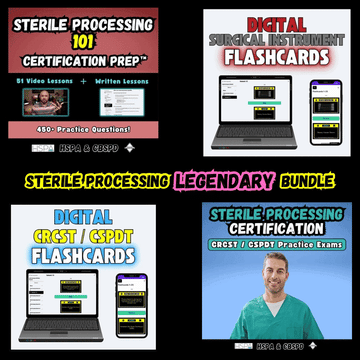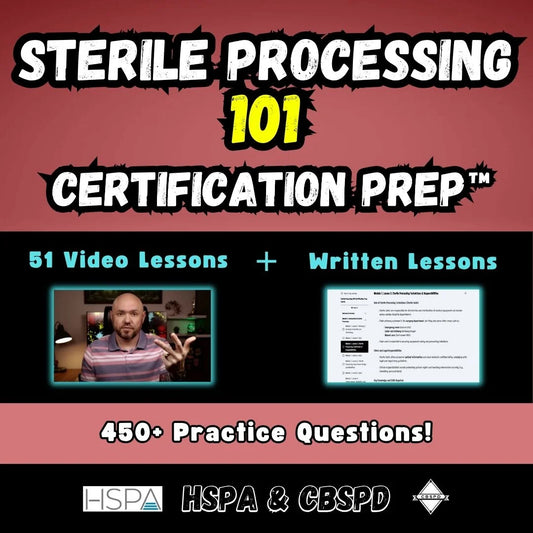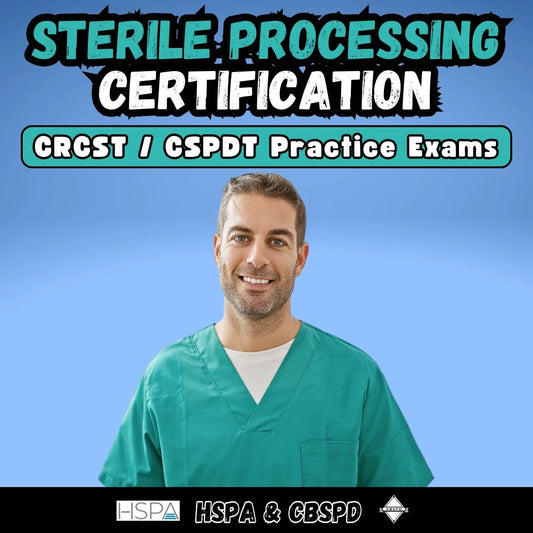Unveiling the Power of Disinfection in Sterile processing

In the battle against harmful microorganisms, disinfection stands as a vital line of defense. It is a process that eliminates or reduces the number of disease-causing pathogens on surfaces, objects, and in the air. This blog aims to shed light on the concept of disinfection, exploring its mechanisms, the different methods employed, and its crucial role in sterile processing.
Understanding Disinfection:
Disinfection is the process of destroying or inactivating microorganisms, including bacteria, viruses, fungi, and protozoa, on surfaces, objects, and in the air. It plays a significant role in preventing the transmission of infectious diseases, maintaining cleanliness, and promoting general public health. Disinfection is distinct from sterilization, which refers to the complete elimination of all forms of viable microbial life. While disinfection reduces the microbial load, it may not eradicate all microorganisms, particularly the highly resistant spores.
Levels of Disinfection:
The different levels of disinfection are commonly confused with the Spaulding Classification, which is not the same thing. Disinfection has three distinct levels known as High-level, Intermediate, and Low-level disinfection. All levels of disinfection are classified under the two lower portions of the Spaulding Classification under Semi-critical and Non-critical; the Critical portion of the Spaulding classification refers to any process of sterilization. The Spaulding Classification was developed in 1939 by a microbiologist named Earle Spaulding who came up with this genius process for determining which type of patient care items needed what level of disinfection and/or sterilization according to use and microbial infection risk. Spaulding Classification determines level of disinfection/ sterilization treatment, and disinfection levels refer to the three distinct levels as determined by need.
Mechanisms of Microbial Destruction:
Disinfection works through several mechanisms to neutralize microorganisms and render them unable to cause infections. The key mechanisms include:
- Denaturation of Proteins: Disinfectants disrupt the structure and function of proteins essential for microbial survival. This leads to the denaturation and coagulation of proteins, ultimately killing the microorganisms.
- Damage to Cell Membranes: Disinfectants can penetrate microbial cell walls and membranes, causing disruption and leakage of intracellular components. This interference with cell integrity impairs vital functions, leading to microbial death.
- Inactivation of Enzymes: Disinfectants can target and inhibit essential microbial enzymes, disrupting metabolic processes necessary for microbial growth and survival.
Methods of Disinfection:
Several methods and disinfectants are employed in various settings to achieve effective disinfection. The choice of method depends on the type of microorganism, the surface or object being treated, the level of disinfection required, and the cost of the disinfection process. Some commonly used methods include:
- Chemical Disinfectants: These disinfectants encompass a wide range of chemicals, such as chlorine compounds, quaternary ammonium compounds, hydrogen peroxide, alcohols, and phenols. Each disinfectant has its own spectrum of activity and is suitable for different applications.
- Heat Disinfection: High temperatures can effectively kill microorganisms. Methods like moist heat (washer disinfectors) are commonly used for heat-sensitive and heat-resistant materials, respectively.
- Ultraviolet (UV) Radiation: UV disinfection employs specific wavelengths of UV light to disrupt microbial DNA and inhibit replication. It is commonly used for air disinfection, water treatment, and surface decontamination.
Disinfection in Sterile Processing:
Sterile processing plays a critical role in healthcare facilities, ensuring that medical instruments, equipment, and supplies are free from microorganisms. Disinfection is a key component of sterile processing protocols, complementing other steps such as cleaning and sterilization.
In sterile processing, disinfection is typically employed for semi-critical items that come into contact with intact skin but not mucous membranes or sterile body cavities. Examples include endoscopes, respiratory therapy equipment, and certain surgical instruments. Disinfection procedures may involve chemical disinfectants, manual or automated cleaning, and thorough rinsing to remove organic matter before disinfection.
It is important to note that while disinfection reduces microbial load, it may not eliminate all microorganisms even during High-level disinfection. Therefore, for critical items that come into contact with sterile body cavities or the bloodstream, sterilization techniques such as autoclaving or other validated sterilization methods are required.
Disinfection plays a vital role in combating the spread of infectious diseases and ensuring the safety of all our patients and staff. Proper use of disinfectants and methods of disinfecting is critical.
Share
Let customers speak for us
from 241 reviewsI took the practice test and I got a 91% on my certification exam!!
This course was the extra boost that I needed in order be confident in passing the exam. Thank you for all the information provided. I even refer to your notes while working.
Very helpful to me I can study any where at my own pace and low cost than going to school...I'm glad that there is something like this online to help anyone who want to pursue their career as a sterile processing tech.
I loved it, it’s very informative and the questions are great, it’s a great resource to purchase if you want to prepare for your certification exam!
I’ve really enjoyed this course so far. It delivers the information in a straightforward, digestible way. The Sterile Guy has compiled a highly effective program. Thanks very much from one highly satisfied customer!
The practice exams are detailed and easy to navigate. Brandon continues to show his passion in this industry by sharing his knowledge with up-and-coming techs. I also recommend investing in his flashcards. It has helped me greatly. Thank you, Brandon!,
These practice quizzes really helped me get the hang of answering questions related to instruments and the processes of preparing them! I even bought them twice cause I ran out of time lol. Super helpful!
I recently completed the Sterile Processing Guy course online and was extremely impressed. The content was clear, well-organized, and easy to follow. It helped me better understand important concepts like decontamination, disinfection, and sterilization. I appreciated how practical and informative the lessons were, it definitely made studying for certification feel more manageable. I highly recommend this course to anyone pursuing a career in sterile processing!
I won’t lie, I failed the first time around. So I decided to buy this practice test and I passed with flying colors my second go. Highly recommend to anyone interested in the CER, it helped a lot!
The flash card quality is amazing! Bravo sir! The card quality is way above average, questions are great! I’m still learning, utilizing these cards and your practice tests. Thanks for all the info!
I passed the CRCST exam. Taking reg sterile guy practice test over and over definitely helped get the job done.
This certification prep course is a must. Great videos with a lot of information and plenty of of practice exams.
These flashcards are so helpful and well put together. Highly recommend!
I'm really happy that I purchased the SP practice exam. I love how if you answer the question incorrectly, the correct answer will include the page number of the text book to find the answer. The questions are literally based on the textbook. I suggested "The Sterile Processing Guy" to my friend that is studying for the exam as well.








